Selecting the appropriate SaaS business model will help you to feel more confident and set the tone, much as choosing the ideal dress for a major event. With good cause, SaaS—Software as a Service—has become rather popular. From streamlining processes to providing tools available anywhere, any time, SaaS presents countless opportunities for companies. Businesses similar to Mailchimp and Shopify? They nailed their models, and today they are smashing it. The drawback is that no model fits every company, though. You need the correct one to keep ahead of rivals, satisfy consumers, and drive business expansion. All set to enter the SaaS universe and identify your ideal fit? Let’s depart.
What is the SaaS Business Model?

In the realm of corporate models, SaaS—that is, Software as a Service—is revolutionary. Imagine being able to acquire strong tools for a nominal monthly or annual cost instead of having to pay a fortune up front. The SaaS company model has charm in that regard. Using this model, firms such Netflix, Salesforce, and Zoom have developed their empires. No downloads, no difficult installations; simply open your browser and get right to work. Everything is kept in the cloud so you may access your tools from anywhere.
SaaS is far more user-friendly than conventional programmes. People bought CDs, installed programs, and hoped their PCs wouldn’t crash back in the day. Currently? SaaS takes care of all for you—updates, security, storage. This is a business model that brings convenience and releases tension.
The advantages are not limited there. Because this strategy is scalable—that is, it expands with your company. Demand advanced functionality or more users? Simple update mechanism. Furthermore reasonably priced, SaaS is perfect for small firms and startups. Whether you manage a giant like Amazon or a little café, the SaaS business model provides the dependability and adaptability required for success.
Why SaaS is in Demand for Businesses?
In the business sector, SaaS is exploding and makes perfect sense. Imagine running a business free from concern for handling countless updates or installing large-scale programs. Everything happens in the cloud with SaaS—fast, simple, and easily available from anywhere. This company model provides the tools you need without busting the budget.
SaaS is rather popular for mostly one reason. scalability. Growing businesses may quickly update new users or features without any interruption. For instance, by providing customizable options, Shopify enables modest businesses to become worldwide e-commerce behemoths. Mailchimp then provides companies, regardless of their 100,000 or 100,000 subscribers, the tools they need to launch email campaigns. Not stressed, not bothered at all.
Regular income is another main advantage. Businesses get paid either monthly or annually; they do not only close one deal. It is consistent, reliable income that enables business to create future plans. SaaS models also give worldwide reach. From a laptop in Kyiv, you may run your business from New York, service clients in Tokyo, and oversee it all.
All told, SaaS simplifies life for business. It’s made for expansion, versatile, and reasonably priced. Not surprisingly, businesses all around are riding the SaaS train!
Key Advantages of SaaS Business Models

To be very honest, operating a business is difficult. But models of SaaS businesses? They simplify things considerably. Scalability is definitely one major benefit. Suppose your business is expanding rapidly and you now have to double the user count using your program. Using SaaS, no trouble at all! You only changed your strategy. When demand surged during the epidemic, Zoom, for instance, grew from local gatherings to webinar hosting for thousands.
Regular income is another advantage SaaS gains. Ignore one-time sales; this approach guarantees consistent income. Subscriptions are the lifeblood of business like Dropbox and Adobe; they give consistency and enable better future planning. Predictable financial flow also helps to control stress.
Then there is leeway in changing things. Updates can be rolled out by SaaS business without requesting user downloads. Has to be corrected a bug? Add a functionality? carried out quickly! It’s a lifesaver, particularly for applications like Slack or HubSpot where real-time updates satisfy clients.
Not to be overlooked is client loyalty. Users pay consistently, hence they stay around whether they are happy. Contented consumers equate with consistent development and long-term connections. Oh, and SaaS has world appeal. Without ever visiting Ukraine, you can be a tiny entrepreneur selling to business in the United States or Japan.
SaaS excels here most of the time.
- Growing teams: Simply add people using Trello.
- Seasonal companies: Grow at busiest periods.
- Remote work: Teams can use SaaS products including Google Workspace from anywhere remotely.
Simply said, SaaS business models are ideal for contemporary businesses trying to expand, change, and control the world market.
Overview of SaaS Business Model Types
As varied as the companies using them are SaaS business models. Their design is meant to fit several sectors, consumer demands, and budgets. SaaS organizations have choices for everyone from providing free basic versions to developing highly customized programs. Let’s explore some of the most often used models and observe their practicality.
Freemium Model
One brilliant model to draw consumers is the freemium model. Offer a free, basic version of your program, then charge for sophisticated capabilities. This approach enables business to rapidly create a sizable user base. Consider Mailchip, for instance. For free up to 500 subscribers, they let small business send emails. As a company expands, they pay for luxury tools such A/B testing and automation. There is a win-back here. Users of the program test without risk, and companies get devoted consumers. Startups who need to be discovered quickly will find Freemium ideal.
Flat Pricing Model
Among the simplest SaaS models is flat pricing. Whether or not you use the program, you pay a set cost. Customers who desire surprises free from their bills find this simplicity appealing. Starting at just $2.75 per month, HostGator presents flat pricing for its web hosting solutions. No matter their degree of use, consumers pay consistent fees and have access to a set of capabilities. For business looking to eschew intricate pricing systems, this model performs nicely. The advantage of flat price is simplicity—that is, easy sellability.
Usage-Based Pricing
Exactly what it sounds, usage-based pricing is paying according on how much you use the program. For companies who prefer not to spend too much for features they hardly use, this strategy is excellent. Think of Amazon Web Services, or AWS. Consumers pay for bandwidth, computational capability, or storage space they really need. Small businesses or startups with changing needs will find it perfect. Besides, it feels reasonable—why pay more if you hardly use anything? This approach is becoming more and more popular in SaaS since it is all about justice and flexibility.
Tiered Pricing
Tiered pricing allows companies to present several packages catered to various consumer needs. Every level boasts unique qualities and a different price. For example, Shopify’s monthly rates call for $29 to $299. Whereas a big merchant would choose sophisticated features, a small shop would choose the basic package. This model lets SaaS companies target different client groups without unnecessarily complicated matters. It’s all about provide them choices without overloading them. For SaaS products with unique feature sets appealing to diverse markets, tiered pricing performs effectively.
Per-User Pricing Model
Among the SaaS products teams utilize, per-user pricing is somewhat common. Simply said, the fee increases with increasing user count. Companies requiring software for big teams will find this strategy ideal. Salesforce and other CRM systems run best on per-user pricing. For every employee who makes use of the system, a corporation pays a certain fee. Growing companies especially like it as it’s easy to scale. For tools where individual user access is crucial and guarantees everyone in the team has the tools they need, this model performs extremely effectively.
Hybrid Pricing Model
Given the ability to mix and match, why keep to one price model? Combining features of several models, the hybrid pricing strategy serves a larger audience. A SaaS corporation might, for instance, charge per-user fees for higher capabilities while providing a freemium edition. This method offers most adaptability. HubSpot charges for marketing and sales additions while providing free CRM features under a hybrid strategy. It’s a fantastic model to make money off of premium services and draw in fresh people. Adaptability and making sure no consumer feels excluded define hybrid models.
Pay-As-You-Go Model
For companies want complete control over their costs, pay-as-you-go is ideal. Like usage-based pricing, you pay only for what you use, but more precisely. Startups or business with little resources would find it perfect. Charging a nominal fee for every transaction, Stripe, a payment processing SaaS company, bases on this model. No upfront expenses, no long-term commitment; just pay as you expand. This model guarantees companies only spend their money when they are earning it. For businesses needing scalable, cost-effective solutions, it’s adaptable, clear, and ideal.
White-Label SaaS Model
The white-label SaaS model lets business rebrand and market software as theirs. It’s like running a SaaS business free from development’s headache. This approach is often used by marketing and technology firms to provide customers customized solutions. A corporation might, for example, re-market a white-labeled SEO tool under their own name. Expanding services without large R&D expenditures is where this strategy excels. White-label SaaS is about providing companies with more choices to expand their products while emphasizing sales and customer connections.
Different SaaS business models are designed to fit particular corporate demands and objectives. Selecting the correct one may either make or ruin the performance of your business.
SaaS Business Model Success Stories

SaaS businesses demonstrate to us that great success can result from even modest starts. Consider Shopify for instance. Originally a basic platform for snowboarding gear sales, today’s top-tier SaaS company runs over 1.7 million retailers all around. Their tiered pricing approach is what drives success. Small stores get all the basics for $29 a month; large-scale business spend $299 for sophisticated capabilities. This adaptability allows Shopify to meet different corporate needs, so enabling businesses to expand without straying from their budgets.
One other SaaS success is web hosting giant HostGator. Using the flat rate approach—just $2.75 per month for excellent hosting—they flourish. Not confusing plans, not hidden expenses. Start-ups and small companies looking for dependable hosting free from complex pricing will find it perfect Millions of consumers came to trust HostGator as it developed a reputation for openness and simplicity.
Tailoring their SaaS business models to their consumers was something Shopify and HostGator both realized was vital. While HostGator presented hassle-free hosting solutions, Shopify concentrated on scalability for e-commerce.
The numbers are real: HostGator hosts millions of websites and Shopify is valued at more than $60 billion. These tales show that selecting the appropriate SaaS business model is not just wise but also the formula for success over the long run.
Choosing the Right SaaS Business Model for Your Company

Selecting the correct SaaS company model can be like deciding on the ideal pair of shoes. It has to develop with you and complement your company objectives. Analyze first what your business actually needs. Are you a startup trying to draw fresh customers? Perhaps then the freemium model is the best one. Are you looking for consistent money? Apply subscription-based pricing.
Now consider your clients as well. Because it’s straightforward and consistent, small firms may want flat pricing. Bigger businesses could require flexibility, so a tiered or hybrid model could be perfect. Your model should fit their requirements rather than only your own.
Remember scalability too. Your SaaS should change with business size. Look at Slack or Zoom; when consumers’ needs grew, they nailed it by providing several pricing options.
Here’s a pro: test prior to making commitments. Starting with one model, change it depending on user comments. The SaaS universe is dynamic; what works now could not be so tomorrow. Make good decisions; your company will reward you later!
Result
Modern firms’ foundation is SaaS business models. Businesses trying to expand would find them a no-brainer since they provide cost, scalability, and flexibility. Choosing the correct model will change your success whether your company is a startup using Mailchimp’s freemium products or a big business scaling with Shopify’s tiered pricing.
Still, avoid merely replicating what other people do. Examine your needs; know your audience; and be ready to change. Innovation is about offering value rather than only about great technology. Globally anticipated to reach $700 billion by 2030, the SaaS business is expanding. Are you prepared to ride?
